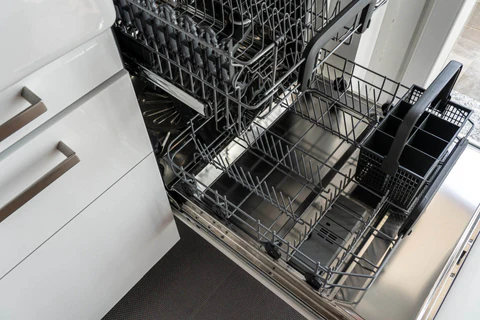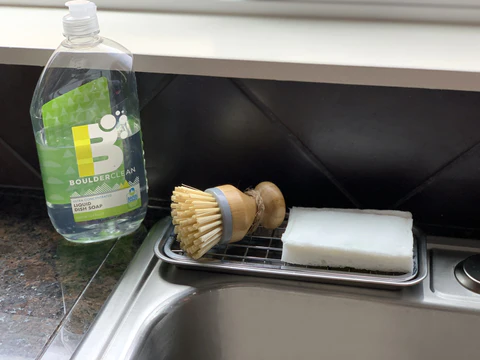A Clean Sweep For The Kitchen
A reusable water bottle. The can opener. The coffeemaker. Some kitchen items — particularly those that don’t always seem dirty — are often overlooked when it comes to regular and thorough cleanings. Check out this list of surprising dirt-and-germ hiding spots and find out how to wash them properly.

Water Bottle
How dirty could a water bottle possibly be? It only comes into contact with clean water and germs from your own mouth, right? The problem is that water bottles harbor the very conditions — humidity plus time, plus occasional heat (like when you leave the bottle in your car) — that favor the growth of bacteria, molds and yeasts. And a quick rinse at the end of the day isn’t enough to get rid of them. Instead, wash your bottle and its cap daily with warm, soapy water, using a long-handled brush to reach the bottom and inside the cap. Or, use the dishwasher if your bottle is dishwasher-safe. And be sure to air-dry thoroughly, leaving the bottle uncapped until you refill it for its next outing.

Dishwasher Filter
Ever pull out a load of dishes to find it coated with a layer of baked-on grit? The culprit is usually a clogged filter — that new-fashioned addition that makes modern dishwashers so quiet. To clean the filter, check your owner’s manual. You’ll typically find the filter at the bottom of the dishwasher. Remove the bottom rack, then unscrew the filter in a counterclockwise direction. Pull it out gently, along with any flat mesh filter that it fits with. Check the sump (the cylindrical hole where the filter goes) and remove any chunks you find there. Then submerge the filter pieces in a sink filled with warm soapy water and scrub away dirt with a damp, soapy soft cloth or sponge (the parts are delicate, so hold back the abrasive materials and elbow grease). If there is any oily film or residue over the pieces, pour boiling water directly over them to remove it. Many dishwasher manufacturers recommend cleaning out the filter twice a year, but if yours needs it more often, you’ll be the first to know — when those dishes stop coming out nice and clean.

Coffeemaker
Although you’d think a coffeemaker would be germ-free (boiling water runs through it, after all), the heat and humidity inside it help bacteria thrive. A 2011 study by NSF International, an independent public health and safety organization, found that a coffeemaker reservoir was one of the most-germ-laden spots in the home — ahead of doorknobs and even the handle on the toilet. NSF recommends following the manufacturer’s instructions for daily cleaning, plus doing a monthly vinegar treatment: Pour white vinegar into the reservoir and let it stand. Then run the coffeemaker with fresh water until the aroma of the vinegar subsides.

Dish Sponge
It’s ironic that the tool we use to wash things — things we eat off of! — has been found by so many studies to be the most germ-laden item in the house. Think foodborne pathogens, yeasts and mold. To kill all that messy stuff breeding in the crevices, toss your sponge in the dishwasher along with your dishes after you’re done washing up for the evening. Then run it on the hottest and longest cycle. And — this is key — use the dry cycle. Or, heat a wet sponge in your microwave for two minutes at full power. Replacing your kitchen sponge every couple of weeks will also keep you in good shape.

Stove Knobs
Despite our best efforts to wash our hands before cooking, stove knobs also harbor all sorts of bacteria, yeasts and mold. Luckily, cleaning them is a snap, since the knobs are removable. Take them off once a week and plunge them into warm, soapy water, scrubbing crevices with a toothbrush if necessary. Dry completely and pop them back into place.

Cutting Boards
Regardless of whether you use hardwood, bamboo, plastic or glass, the USDA recommends washing all cutting boards in hot, soapy water after each use, then air-drying or blotting dry completely with paper towels. And if you haven’t gotten the memo, keeping separate cutting boards — one for raw meats and fish and another for produce or cooked items — also fights the spread of E. coli and the like. To remove stains, try rubbing your board with a paste of coarse salt and lemon juice. (This helps with odors, too.) For the occasional serious deep-clean, the USDA advises using a solution of 1 tablespoon of bleach per gallon of water (flood the surface, then let stand for a few minutes). Rinse well, then air-dry.

Can Opener
Do you toss your opener back in the drawer after each use? It’s time to rethink your routine. Can openers come into contact with food, so it stands to reason that they should be cleaned after every use. The easiest way? Run them through the dishwasher with the dry function to prevent rusting the blade. If your can opener isn’t dishwasher-safe, wash it in warm, soapy water. If you’ve been lax in the past, you can use a toothbrush to scrub around the blade. Be sure to air-dry it completely before putting it away.

Refrigerator Vegetable Drawer
As you might occasionally be reminded by newspaper headlines, the produce you bring home from the grocery store and farmers market can carry foodborne pathogens. Since we tend to eat these items raw, it makes sense to wash your vegetable and fruit drawers with warm, soapy water regularly. NSF recommends doing it once a month.
